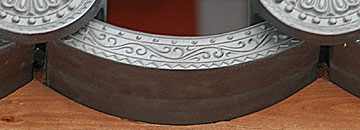|
||
 |
||

Yakushiji
Daikoudou 薬師寺大講堂 (Nara)
(C)2001 Japanese Architecture and Art Net Users System. No reproduction or republication without written permission.
掲載のテキスト・写真・イラストなど、全てのコンテンツの無断複製・転載を禁じます。
|
||||||
| henkou karakusamon 扁行唐草文 | ||||||
| KEY WORD : architecture / roofing tiles | ||||||
| An
asymmetric arabesque pattern. Most arabesque patterns have a centrally positioned
motif *chuushinkasari
中心飾 from which flow rhymical arabesques that are exactly the same but run in opposite
directions *kinsei karakusamon
均正唐草文. The henkou type pattern, however, runs continuously from one end
of the broad to the other. One example, on a tile unearthed at Fujiwarakyuu 藤原宮
(694-710), has a predominant curvilinear core from which, and around which spring
dynamic lines ending in simple curlicues. Some scholars suggest that the curlicues,
especially those passing the center of the tile, might represent a cloud motif.
Some of these continuous patterns have no end borders wakitai 脇帯. Others
have clearly defined end borders filled with a continuous linear zigzag motif
*kyoshimon 鋸歯文 created
along the lower border *shimotai
下帯. The upper border uetai 上帯 is filled with a bead pattern *shumon
珠文. Some henkou patterns resemble the so-called honeysuckle motif and are
called henkou nindou karakusamon 扁行忍冬唐草文. |
||||||
 Yakushiji
Daikoudou 薬師寺大講堂 (Nara)
|
||||||
| REFERENCES: | ||||||
| EXTERNAL LINKS: | ||||||
| NOTES: | ||||||
(C)2001 Japanese Architecture and Art Net Users System. No reproduction or republication without written permission. 掲載のテキスト・写真・イラストなど、全てのコンテンツの無断複製・転載を禁じます。 |
||||||